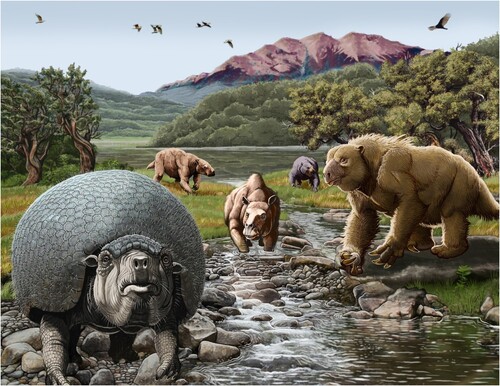Figures & data
FIGURE 1. A, location of Yauri city (Espinar) in relation to other landmarks in southern Peru. B, map of Yauri (Espinar) indicating sampled tuff (star, E19-14), existing radiometric dates (squares), and known fossiliferous localities (dots) as follows: 1, Santísima Cruz [MUESP 21]; 2, Alto Huarca; 3, Huacracanto [MUESP 10]; 4, Huisaccollana [MUESP 11/ESP 9-1]; 5, Villa Versalles [MUESP 4, MUESP8, MUESP 9/ESP6]; 6, AAHH A A Cáceres [MUESP 20]; 7, Estadio [MUESP 3]; 8, NW-Estadio [E19-13]; 9, Los Angeles; 10, Versalles tuff (Martínez et al., Citation2020); 11, Cerro Pucará (Kar et al., Citation2016). C, chronostratigraphic position of fossiliferous localities (numbers as in inset B) and existing radiometrically dated tuffs from Member C (†Kar et al., Citation2016; ‡Martínez et al., Citation2020). Maps sources: 30 arc-second DEM of South America (Data Basin Dataset), U.S. Geological Survey's Center for Earth Resources Observation and Science (EROS).
![FIGURE 1. A, location of Yauri city (Espinar) in relation to other landmarks in southern Peru. B, map of Yauri (Espinar) indicating sampled tuff (star, E19-14), existing radiometric dates (squares), and known fossiliferous localities (dots) as follows: 1, Santísima Cruz [MUESP 21]; 2, Alto Huarca; 3, Huacracanto [MUESP 10]; 4, Huisaccollana [MUESP 11/ESP 9-1]; 5, Villa Versalles [MUESP 4, MUESP8, MUESP 9/ESP6]; 6, AAHH A A Cáceres [MUESP 20]; 7, Estadio [MUESP 3]; 8, NW-Estadio [E19-13]; 9, Los Angeles; 10, Versalles tuff (Martínez et al., Citation2020); 11, Cerro Pucará (Kar et al., Citation2016). C, chronostratigraphic position of fossiliferous localities (numbers as in inset B) and existing radiometrically dated tuffs from Member C (†Kar et al., Citation2016; ‡Martínez et al., Citation2020). Maps sources: 30 arc-second DEM of South America (Data Basin Dataset), U.S. Geological Survey's Center for Earth Resources Observation and Science (EROS).](/cms/asset/11e91000-13fe-4760-b8b4-9e86d9737cd6/ujvp_a_2237079_f0001_oc.jpg)
FIGURE 2. Andinoglyptodon mollohuancai gen. et sp. nov. (holotype, MUESP 4). Skull in A, anterior view; B, left lateral view; C, dorsal view; D, occlusal view; E, posterior view. Left mandible in F, occlusal view; G, medial view; H, lateral view. Abbreviations: ac, articular condyle; bo, basioccipital; bs, basisphenoid; cp, coronoid process; dmx, descending process of the maxillae; f, foramina; fr, frontal; iof, infraorbital foramen; lf, lacrimal foramen; Mf1, Mf2, Mf7, Mf8, upper molariform tooth positions; mf1, mf6, mf8, lower molariform tooth positions; mfo, mental foramina; mpsq, mastoid process of the squamosal; nc, nuchal crest; no, narial opening; oc, occipital condyle; or, orbit; pa, parietal; pe, petromastoid; pgf, postglenoid fossa; pop, paraoccipital process; prm, palatal ridge of the maxillae; s, mandibular symphysis; so, supraoccipital; sq, squamosal; ss, symphyseal spout; v, foramen ovale; zysq, zygomatic process of the squamosal. Scale bar equals 5 cm.
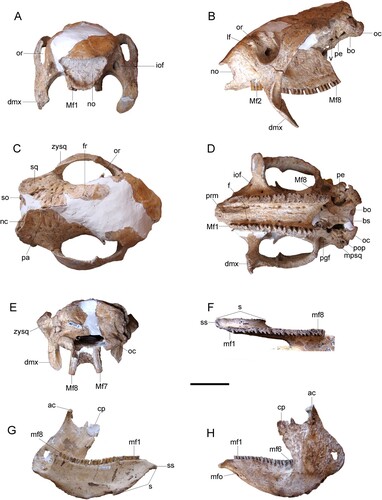
FIGURE 3. Andinoglyptodon mollohuancai gen. et sp. nov. (holotype, MUESP 4). A, dorsal carapace; B, anterior osteoderms; C, lateral osteoderms; D, dorsal osteoderms; E, portion of accessory caudal ring; F, portion of caudal ring 2 or 3; G, H, caudal rings 4, 5, or 6; I, right femur in dorsal view. Abbreviations: dro, distal row of osteoderms; fh, femoral head; gt, greater trochanter; pro, proximal row of osteoderms; pt, patellar trochlea; tt, third trochanter. Scale bars equal 5 cm.
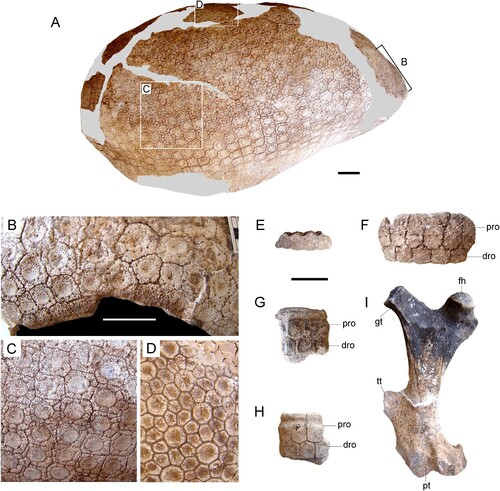
TABLE 1. Cranial and mandibular measurements (mm) of Andinoglyptodon mollohuancai (holotype, MUESP 4). Abbreviation: e, estimated. Measurements modified from Von den Driesch (Citation1976).
FIGURE 4. Comparative schematics of glyptodontine skulls. Andinoglyptodon mollohuancai (holotype, MUESP 4): A, anterior view; B, left lateral views. C, Paraglyptodon uquiensis (MACN-Pv 5377) in anterior view. D, cf. Paraglyptodon chapalmalensis (MPP 4676) in lateral view (reversed). E, F, Glyptodon muñizi (MACN 8706) in E, anterior view; F, left lateral view. Scale bar equals 5 cm.
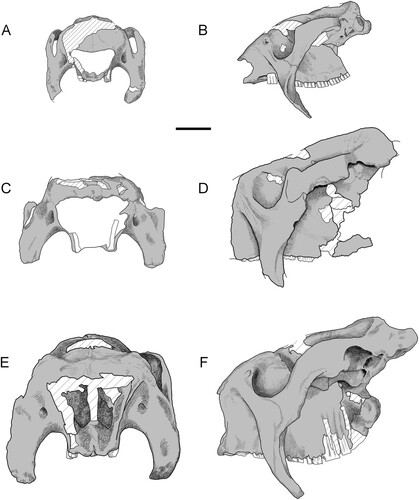
TABLE 2. Measurements (mm) of the femur of Andinoglyptodon mollohuancai (holotype, MUESP 4). Modified from Von den Driesch (Citation1976).
FIGURE 5. Ground sloths and Toxodontidae from Espinar. A, cf. Megatheriops rectidens, skull (MUESP 10) in left lateral view. Simomylodon uccasamamensis skulls in left lateral view: B, juvenile skull (MUESP 11); C, adult skull (MUESP 16). Proscelidodon sp. (MUESP 20): D, skeleton in anatomical connection; E, skull and mandible in lateral view. F, Posnanskytherium viscachanense, skull (MUESP 3) in left lateral view. The skulls are oriented with the occipital condyles horizontal. Abbreviations: cav, caudal vertebrae; Cf, upper caniniform; crv, cervical vertebra; hu, right humerus; I2, upper incisive tooth 2; j, jugal; lbv, lumbar vertebrae; lf, lacrimal foramen; M1, M3, upper molar tooth 1 and 3; Mf1–Mf3, upper molariform tooth positions; mn, mandible; n, nasal; no, narial opening; oc, occipital condyle; or, orbit; P1, P4, upper premolar tooth 1 and 4; pl, pelvis; pmx, premaxilla; ra, right radius; sa, sacrum; sc, left scapula; sk, skull; trv, thoracic vertebrae; ul, right ulna; zmx, zygomatic process of the maxilla; zysq, zygomatic process of the squamosal. Scale bars equal 5 cm.
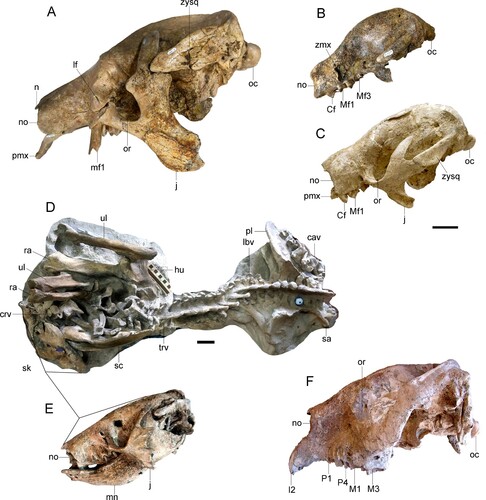
FIGURE 6. Snout and dentition of mammals from Espinar in ventral view. A, Andinoglyptodon mollohuancai; B, cf. Megatheriops rectidens; C, Simomylodon uccasamamensis; D, Posnanskytherium viscachanense. Measurements for the relative muzzle width (1, width at labial Mf1; 4, width at lingual Mf4) are shown for Andinoglyptodon. Scale bar equals 5 cm.
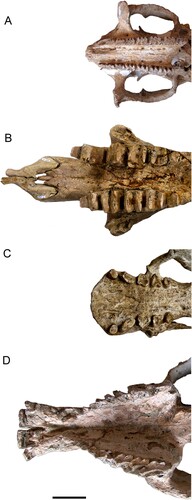
TABLE 3. Selected cranial measurements (mm) of cf. Megatheriops rectidens (MUESP 10), Simomylodon uccasamamensis (MUESP 16), Proscelidodon sp. (MUESP 20), and Posnanskytherium viscachanense (MUESP 3). Abbreviation: e, estimated. Measurements modified from Von den Driesch (Citation1976).
FIGURE 7. Map showing selected Upper Miocene–Pliocene localities (stars) in Peru, Bolivia, and Argentina, where the mammalian genera discovered in Espinar (silhouettes) have been documented. Peru: 1, Espinar. Bolivia: 2, La Paz; 3, Ayo-Ayo; 4, Choquecota; 5, Pomata-Ayte; 6, Inchasi; 7, Casira. Argentina: 8, Casira; 9, Maimará; 10, Uquia; 11, Huayquerías; 12, Mar del Plata. Map source: U.S. Geological Survey's Center for Earth Resources Observation and Science (EROS).
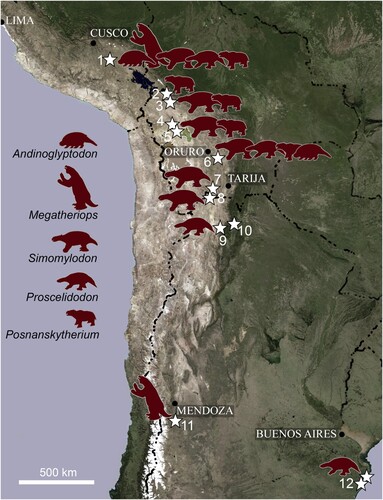
FIGURE 8. Anterolateral carapace osteoderms: A, Andinoglyptodon mollohuancai holotype MUESP 4; B, cf. Andinoglyptodon (MNHN-Bol-V 006369) from Inchasi. Scale bar equals 5 cm.

FIGURE 9. Life reconstruction of the Early Pliocene mammalian fauna from the Andean plateau of Espinar. From left to right: Andinoglyptodon mollohuancai, Simomylodon uccasamamensis, Posnanskytherium viscachanense, Proscelidodon sp., and cf. Megatheriops rectidens. Art: Jorge A. González.
